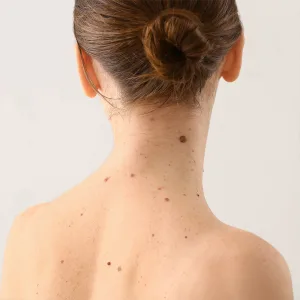Persons with an increased risk
Persons showing one or several of the following signs should protect their skin particularly diligently against the sun and examine themselves regularly for any changes in the skin.
- More than 100 moles on the body
- Moles with an irregular shape and colour
- Previous skin cancer
- Immunosuppression (a person's natural immune system has been weakened by illness or suppressed by medication, like after an organ transplant, for instance).
It should also be discussed with a doctor if regular medical skin checkups are required.
Persons with a direct relative (parents, siblings, children) who previously suffered from melanoma may also have an increased skin cancer risk and should discuss this with their doctor.
Suspicious changes in the skin
The pigment cells produce the pigment melanin and can form moles, also known as liver spots or birthmarks. Some are congenital, others develop over a lifetime. Direct sunlight promotes the development of moles.
In principle, moles are, and in most cases remain, harmless. In rare cases, moles may turn into skin cancer. Around one-fifth of all melanomas develop from existing moles. The majority of melanomas are new. Melanoma may develop on any part of the skin, even on the genitals or beneath the toe or fingernails. There are also melanomas that are light in colour and therefore hard to recognise.
Suspicious changes can be detected on the skin. Any mole that is very different in form and colour from the others or which changes should be examined by a doctor.


